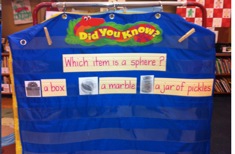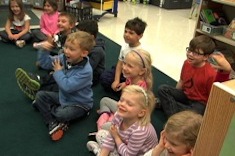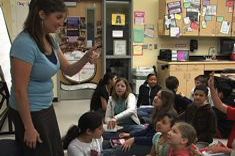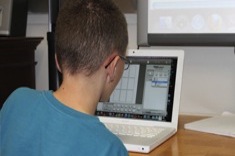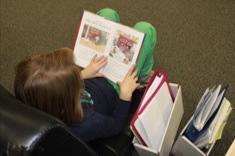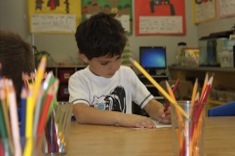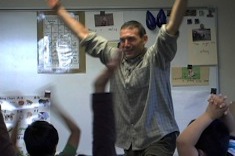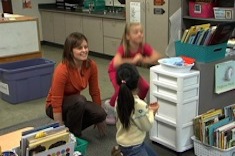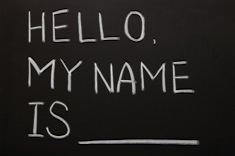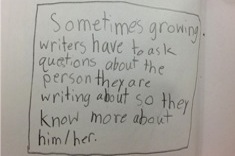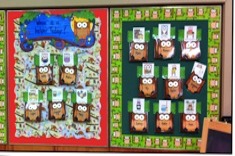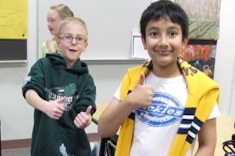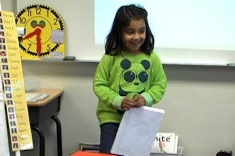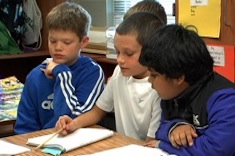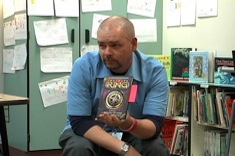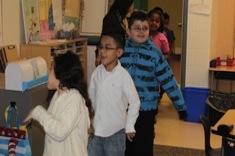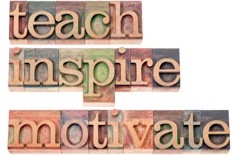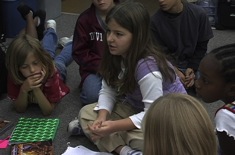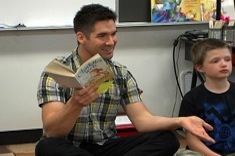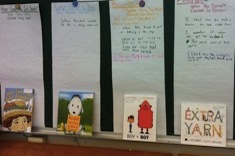Community Building
It's one of the big paradoxes of literacy instruction - students best learn how to read and write independently when they have a strong community of support in classrooms. How teachers build those thoughtful, kind, and challenging classroom communities is explained in these resources.
Latest Content
What Information Is Good Information? Smooth and Effective Transitions to Middle School
Gretchen Taylor explains her role in observing Maria’s fifth-grade classroom, and then building a relationship with students and their families.
Kindergarten Moments Count: Question of the Day
Keri Archer makes the most of the time her kindergarten students spend transitioning into her classroom with her Question of the Day.
Goldilocks and the Three Bears: Reading and Community in Kindergarten
Mandy Robek leads her kindergartners in a shared reading and performance of the classic tale Goldilocks and the Three Bears.
The Truth About Building a Writing Community in Middle School
Building a sense of community is complicated in middle school classrooms. Katie Baydo-Reed considers her eighth graders, and is surprised at what endures most with these young teens.
Building a Reading Community with Edmodo
Katherine Sokolowski discovers Edmodo is a wonderful tech tool for helping her fifth graders become more independent and supportive of everyone’s reading choices.
Supporting Introverts in a First-Grade Classroom
Courtney Pawol looks at how being an introvert affects her role in learning communities, and then moves from insight to practical changes to help the introverts in her first-grade classroom.
Make a Note
Why is Leslie Woodhouse so forgetful? It’s all part of a not-so-devious plot to teach her preschool students the power of creating and leaving notes throughout the classroom.
Linking Movement, Minds, and Literacy in Kindergarten
Max Brand explains how movement activities in classrooms with young learners can be so much more than a brain break or “getting the wiggles out”: movement can forge potent connections between mind, body, and story. The essay includes two video examples.
Movement with First Graders
Katie DiCesare leads her first-grade students through movements and a song, and explains in the debrief why movement activities are valuable for young learners.
My Name Is Not Julie
Ellie Gilbert is deeply moved when her high school student connects to a text in a startling way. It’s one of those magic moments that keeps teachers coming back to classrooms, but is nearly impossible to share with others.
Lists, Facts, and Reports: Conferring with Anna
Franki Sibberson confers with fourth grader Anna to help her connect report writing with her love of animal lists.
Building Peer Conferring Skills in the Primary Grades
Ann Marie Corgill questions whether her second graders are ready for peer response. She finds that with some guidance and construction of anchor charts together, the answer is a resounding yes.
Classroom Jobs Build Community
Keri Archer describes her process of creating a jobs list for her kindergartners, as well as how she has adapted the tasks based on the evolving class community.
Lifting the Quality of Peer Response
Tony Keefer discovers that his fourth-grade students need focused instruction and support to strengthen their peer conferring skills. Tony shares tips and two video examples from his classroom.
Whole Class Writing Share: Teaching Response Skills in 1st Grade
Katie DiCesare’s first graders respond to their classmates’ writing, using questions they developed together over time.
Brainstorming Student Blogs
Franki Sibberson works with a group of students who want to create a collaborative blog of interviews. The discussion reveals some of the challenges of blog writing, including consistent posting and developing topics that might endure over time.
Book Talks in 4th Grade
Tony Keefer previews Infinity Ring with his fourth graders, and talks about the value of book talks for building a reading community.
Bully Literacy
Heather Rader shares texts for building understanding about bullies.
Fun in January: A Mock Caldecott Unit
Katherine Sokolowski discovers a seven-day Mock Caldecott unit is a fun way to build a reading community by predicting the winners, and Skyping with another class to share results.
Eliminating the Conga Line: Teaching Young Children About Strategic Thinking
Clare Landrigan and Tammy Mulligan manage to synthesize workspace cleanup, student independence, and a concrete analogy for strategy work in classrooms.
Writers Inspiring Writers
Melissa Styger invites colleagues and family members into the classroom to share their writing process with students.
Teachers’ Night Out: Reclaiming Our Fearlessness
It’s hard to keep your teaching mojo high when standards are grinding you down. Gretchen Taylor is inspired by watching an aerial performer to consider harnesses and fearlessness in a new way.
Peer Conferring: The “Try It On” Phase
Amanda Adrian continues her series on how teachers can scaffold and model peer conferring. In this installment, Amanda uses the fishbowl technique with students.
Second-Grade Writing: Adding Details and Descriptive Language
In this first video from a four-part series, Sean Moore leads a writing workshop focused on adding more details and descriptive language to writing. He begins with the classic Charlotte’s Web as his mentor text.
Poetry All Year Long
Ann Williams shares how she builds a love of poetry in her fourth-grade classroom all year long.
Teacher Vulnerability
Julie Johnson writes about renewal and staying centered during tough teaching times.
Creating Anchor Charts with Multiple Classes
It’s a dilemma many middle school teachers face. How do you construct anchor charts with multiple groups of students, when only one chart will be hung in the room? Katherine Sokolowski explains how she ensures all classes have input and a “clean slate” in constructing charts.
Reading as Reward
Principal Jennifer Schwanke finds herself on a mad dash to buy a baked potato for a struggling reader, and this is the moment that crystallizes for her everything that is wrong with most reading rewards (especially those involving food).
Ten Classic Ideas That Still Work
Teachers are always on the hunt for something new, even as we cherish what works well year after year. Franki Sibberson lists the activities that have stood the test of time in her classroom.
Good News: Your Teacher is Calling
Heather Rader and Jennifer Taft share strategies for positive communication with parents.
Browse Content By
Type
Category
- Assessment Tools
- Big Fresh Archives
- Booklists
- Choice Numeracy
- Classroom Design
- Common Core
- Community Building
- Conferring
- Content Literacy
- Digital Literacy
- English Language Learners
- Equity
- Family Relations
- Free Samples
- Guiding Groups
- Leadership
- Literacy Coaches
- Mentor Texts
- Minilessons
- New Teacher Mentors
- Podcasts
- Poetry
- Quote Collections
- Reading Strategies
- Self Care
- Struggling and Striving Learners
- Talking and Listening
- Teacher Study Groups
- Teaching Reading
- Teaching Writing
- Word Study and Vocabulary
Author
- Melissa Quimby
- Nawal Qarooni
- Gwen Blumberg
- Julie Cox
- The Lead Learners
- Hannah Tills
- Josie Stewart
- Ruth Metcalfe
- Mallory Messenger
- Becca Burk
- Jodie Bailey
- Vivian Chen
- Mary Brower
- Tiffany Abbott Fuller
- Stephanie Affinito
- Ruth Ayres
- Leigh Anne Eck
- Heather Fisher
- Shari Frost
- Julie Johnson
- Suzy Kaback
- Gigi McAllister
- Shirl McPhillips
- Melanie Meehan
- Cathy Mere
- Debbie Miller
- Tara Barnett and Kate Mills
- Tammy Mulligan
- Dana Murphy
- Bitsy Parks
- David Pittman
- Brenda Power
- Heather Rader
- Matt Renwick
- Mandy Robek
- Christy Rush-Levine
- Gretchen Schroeder
- Jen Schwanke
- Brian Sepe
- Katherine Sokolowski
- Stella Villalba
- Jennifer Vincent
Grade Level
Choice Literacy Membership
Articles
Get full access to all Choice Literacy article content
Videos
Get full access to all Choice Literacy video content
Courses
Access Choice Literacy course curriculum and training


